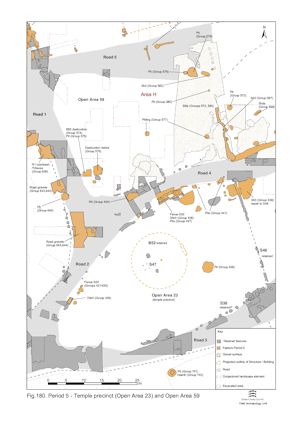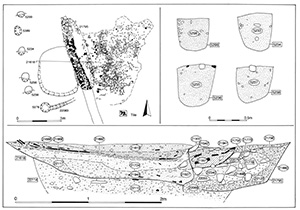
The temple cella (Building 52) and the Period 4 monumental post (Structure 53) continue to occupy the temple precinct throughout the Late Roman period (Figure 180). While there is little sign of significant development or change across the interior of the temple precinct, its boundaries receive attention during Period 5. Other than an attempt to repair the slumping eastern precinct frontage wall, most effort seems to have been focused on the northern perimeter, with successive boundary features and pitting continuing to be located along the edge of Road 4.


It is apparent that the insubstantial nature of the foundations of the eastern precinct wall (Structure 46 Group 426 Period 4) begins to cause severe problems (Figure 199). In particular, Structure 46 subsides into the soft fills of pit 22114 (Group 431 Period 4) and the wall begins to lean westwards (and in the process creates a gap 21778 between the wall and its foundations). Remedial works (Group 439) are undertaken in the late 3rd century AD.
A shallow 'pit' or scoop (21618) is cut into the top of the pit and represents an attempt to remove some of its soft fill and to consolidate it, but also perhaps to facilitate access to the wall foundation for the purpose of repairs. This consolidation work appears to be enclosed by a line of post-holes 5234, 5236, 5238, 5299, 5339, 5378, and a small slot 22083 which may form some sort of a barrier or structure around the excavation and against the precinct wall; possibly even a scaffold?
Slot 21795, at 5m long, is the underpinning trench for the repairs subsequently undertaken. The west face of the wall footing is replaced with roughly coursed tile and mortar (22079) - in contrast to the largely unbonded stone rubble of the earlier build. Scoop 21618 is filled with tile rubble as part of this work. An extensive spread of septaria and tile (21667) lies to the east of the underpinned section of precinct wall. It is unclear whether this represents residue from these remedial works or is derived from the subsequent demolition/collapse of the wall.
A fence (Structure 52 Groups 421, 435) is constructed along the north side of Open Area 23, dividing it from Road 4. The post-holes from which this structure is surmised (Group 421: 5468, 5749, 5849. Group 435: 5183, 5297, 5304, 5323, 5325, 5336, 5343, 5389, 5406, 5415, 5439, 5466, 5470, 5475, 5545, 5647, 5658, 5660, 5892, 5911, 13305, 13307) need not all be directly contemporary, some are earlier than Period 5, and two - 5336, 5545 - might be more properly seen as Period 6 (based on only one and two sherds respectively), but cumulatively they indicate the presence of a fence along this line, continuing the same boundary as seen in the early and mid-Roman periods (Periods 3 and 4). It is also very likely that further components of this fenceline are obliterated by the large pits dug along this boundary in both this period and Period 6.
The Structure 52 fenceline is either related to or supplanted by a series of re-cut ditches represented by a number of shallow fragmentary linear cuts (5404, 5428, 5435, 5473 Group 436), which also run alongside Road 4. Ditch 5473 is somewhat detached but is probably the same, or a very similar, ditch at the south-west corner of the area. Although there is little evidence to demonstrate that this ditch runs all the way along the roadside, it could easily do so but is disrupted by later pitting and masked by overlying unexcavated silt layers.
The Late Roman pits within OA23 are all fairly large, but shallow, and almost exclusively restricted to a peripheral location along the side of Road 4 (5178, 5282/5355, 5313 Group 437; 5165, 5349 Group 441). The exception, and one of the largest and most regularly shaped, is earlier 4th century pit 5026 (Group 438). It occupies a position to the south-east of the temple cella entrance. This siting echoes that of the Period 3B pit cluster (Group 409) set to the north-east of the entrance, although with the clear distinction that this only involves a single pit rather than an inter-cutting sequence of pits dug over an extended period. Whether this piece of 'ritual symmetry' is deliberate is unclear.
Whether peripheral or central, these pits contain similar finds assemblages. Like the Period 4 pits, the high incidence of tesserae and septaria is notable. However, the assemblages are both larger and more varied, with a marked increase in tile, iron nails and animal bone. Among these apparently 'bulk' rubbish assemblages there are items that may have religious or votive significance. Pit 5026 includes 900g of oyster shell, 5178 a bracelet (SF577) and stylus, 5282 an iron blade (SF8217), 5349 six iron hobnails.
Internet Archaeology is an open access journal based in the Department of Archaeology, University of York. Except where otherwise noted, content from this work may be used under the terms of the Creative Commons Attribution 3.0 (CC BY) Unported licence, which permits unrestricted use, distribution, and reproduction in any medium, provided that attribution to the author(s), the title of the work, the Internet Archaeology journal and the relevant URL/DOI are given.
Terms and Conditions | Legal Statements | Privacy Policy | Cookies Policy | Citing Internet Archaeology
Internet Archaeology content is preserved for the long term with the Archaeology Data Service. Help sustain and support open access publication by donating to our Open Access Archaeology Fund.